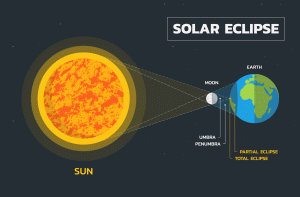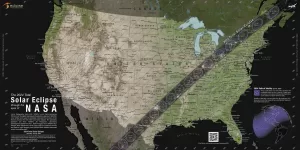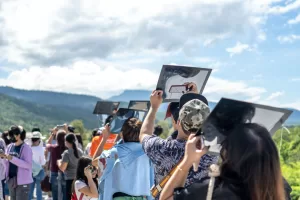Where to go and what to know if you’re hoping to view this celestial phenomenon.
By Josephine Matyas & Craig Jones, F468364
October 2023
Is there any better way to position yourself for the upcoming 2024 total solar eclipse than by traveling in your RV? Our rolling homes allow us to pick a spot along the eclipse pathway, bring some comforts, and enjoy a good view. This rare event will take place on April 8 and is generating lots of media buzz. Campsites along the path are booking up.
WHAT IS A SOLAR ECLIPSE?
When the moon — in its orbit around the Earth — passes between the Earth and the sun, temporarily obscuring our view of the sun, we experience a solar eclipse. A total solar eclipse occurs when the sun is fully blocked by the moon; when only part of the sun is blocked, it’s a partial eclipse.
A total solar eclipse can be viewed only from a relatively small area on Earth — called the “path of totality,” where the sun will be completely obscured by the moon. This occurs somewhere on Earth every 18 months or so. They recur in the same place every 300 or 400 years, which is why the April 8, 2024, event is so cool: The path of totality cuts diagonally across North America.
Spectators will be able to experience extraordinary phenomena — the gradual spread of dusk across the sky, and the sudden appearance of stars and the solar corona, visible as a bright halo around the sun.

A FRONT ROW SEAT
Depending on cloud cover, most of the United States will be able to see some part of the event. Approximately 32 million people live along the path of totality. If you miss the 2024 event, you’ll have to wait until August 2044 to catch the next one, which will be visible across northwestern parts of North America.
The extraordinary April 2024 celestial phenomenon will cross the continent in an arc starting on the coast of Mexico at Mazatlán, then Texas, traveling from the southwestern to northeastern states, and skirting southern Ontario and Quebec as it moves into Canada’s Maritime provinces.
And that’s just the path of totality — where the sun is completely obscured. At each edge of the total eclipse area, the blackout will be only partial, but viewing will still be good.
Along the path of totality, the complete blockage of the sun will last approximately four minutes. Don’t choose that moment to head into your RV to make popcorn!

TAKE PRECAUTIONS
Looking into the sun without eye protection is courting serious eye damage. The international safety standard for eclipse glasses is ISO 12312-2. Be aware that some so-called “eclipse glasses” are fakes. Make sure the glasses you purchase meet the standards and are in good condition and not damaged. Don’t risk harming your eyes.
The American Astronomical Society (https://eclipse.aas.org/eye-safety/eyewear-viewers) offers a list of reputable vendors and tips on safe viewing. Best advice is to purchase early, because there will be a rush for eclipse glasses, and fakes will flood the market to meet demand.
Second, you must wear eclipse glasses at all times if you want to face the sun. But don’t supplement eclipse glasses with telescopes or binoculars! Whatever you do, don’t look directly at the eclipse.
Can’t acquire eclipse glasses? You can use an alternate indirect method. Google directions to make a pinhole projector using a long box, a piece of tin foil, a pin, and a sheet of white paper.

Eye protection is needed for viewing an eclipse ― special glasses or an indirect viewing method.
Third, there are right and wrong ways to use eclipse glasses, and you should practice before the event. For starters, hold them with both hands. Stand with your body facing the sun but looking down. Now, put the glass-es on, fasten them securely, and look up. Don’t try to walk around with them on because — surprise! — you won’t be able to see and could trip over something.
Finally, plan and give yourself time. Massive traffic jams can follow once the eclipse is over. Why not spend an extra night and relax instead of joining thousands of vehicles trying to leave at the same time?
FUN FACTS AND MYTHS
The May 1919 solar eclipse demonstrated that light was bent by the force of gravity, making Albert Einstein a household name overnight and establishing his theory of relativity as one of the singular achievements of humankind.
Some ancient cultures believed that a solar eclipse was the sign of angry gods, marking the beginning of disasters and destruction.
Fear of solar eclipses still exists. People around the world see eclipses as evil omens bringing death and disasters. Myths abound, such as the notion that eclipses cause harm to pregnant women and their unborn children, or that food cooked during an eclipse is poisonous.
WATCHING THE “BIG EVENT”
Note that in the northern reaches, many campgrounds do not open for the season until late May. Call to find out whether the camp-ground you’re interested in will be opening early to accommodate eclipse watchers.
The April 2024 eclipse will be a big deal across the U.S. National Park Service system. Almost 30 parks, trails, and affiliated sites fall within the eclipse’s path, and they are planning special events. Buffalo National River in Arkansas will have interpretive night-sky programs on the days leading up to April 8. Hot Springs National Park in Arkansas is one of two official national parks in the eclipse’s path of totality. Use the NPS Event Calendar (www.nps.gov/planyourvisit/event-search.htm) and filter for the day of the eclipse to see which parks have posted activities.
Half of the 52 Arkansas state parks are located within the path of totality. In southwest Arkansas, the town of Mena is planning a Solar Eclipse Festival from April 5 to 8. As noted, the path of totality will pass directly over Hot Springs National Park. A website lists events in the state linked to the eclipse: https://ar-eclipse.info.
Perryville, Missouri, south of St. Louis, will be in the path of totality, and folks there are planning the Perryville Solarfest. The city is setting up viewing sites, RV camping facilities, and primitive campsites.
 Paducah, Kentucky — a UNESCO Creative City — will also be in the path of totality. Among the campgrounds in Paducah is Duck Creek RV Park. The campground at John James Audubon State Park in Henderson will be close to the action as well. Roadtrek motor-home owners are invited to join an eclipse gathering at Arrowhead Lake Campground in southern Illinois, 60 miles north of Paducah, Kentucky. A group from FMCA’s Roadtrek International chapter will be meeting there.
Paducah, Kentucky — a UNESCO Creative City — will also be in the path of totality. Among the campgrounds in Paducah is Duck Creek RV Park. The campground at John James Audubon State Park in Henderson will be close to the action as well. Roadtrek motor-home owners are invited to join an eclipse gathering at Arrowhead Lake Campground in southern Illinois, 60 miles north of Paducah, Kentucky. A group from FMCA’s Roadtrek International chapter will be meeting there.
Visit Indianapolis, Indiana’s dedicated 2024 solar eclipse website (www.visitindy.com/eclipse) for a viewing map, information on top viewing locations, and a list of RV camping spots. Billing itself “the eclipse capital of the Midwest,” Indianapolis is hosting “Indy Eclipse Weekend” April 5-8, 2024, with games, films, performances, and lectures. NASA chose the Indianapolis Motor Speedway as one of a few select broadcast locations across the United States, and experts will be on hand to answer questions.
At Lake Lemon, located 10 miles northeast of Bloomington, Indiana, the view from Riddle Point Park will be perfect. Lake Lemon will be hosting Total Solar Eclipse by the Lake with camping the night before the eclipse. Festival Country Indiana, a group of communities in Johnson County, south of Indianapolis, will be smack dab in the middle of the path of totality with more than two and a half hours of the eclipse, including more than four minutes of totality. There will be live music, food trucks, and more at the Franklin amphitheater.
Erie is the only sizable Pennsylvania town in the path of totality, and Presque Isle State Park and the Bayfront District along Lake Erie will be prime viewing locations. A list of viewing spots at www.visiterie.com/eclipseerie-2024 will be updated as the date draws closer. The Erie Maritime Museum is hosting a free, family-friendly viewing event focusing solely on the skies.
In northern Maine, remote Aroostook County is where the eclipse will develop last and for some of the longest periods. Many campsites will be open in April: www.visitmaine.net/campgrounds-rv-parks-aroostook-county.
Pelee Island, Ontario, will be the first Canadian soil to see totality, while Belleville, Kingston, and Cornwall are also squarely in the path. Check www.ontarioparks.com to see whether campgrounds will open early in the season for RVing eclipse watchers.
The total solar eclipse will occur directly above a famous astronomical observatory and within an International Dark Sky Reserve at Mont-Mégantic in Québec’s Eastern Townships. The Université de Sherbrooke and Bishop’s University will provide areas on their campuses where visitors can gather. The Club des Astronomes Amateurs, a group of amateur astronomers in Sherbrooke, is organizing outreach activities for its members and the general public.
In the province of New Brunswick, the city of Fredericton is creating a celebratory long weekend to encourage visitors to watch the eclipse. Canadian astronaut Chris Hadfield will be in nearby Florenceville on the day of the eclipse. Miramichi is planning a weeklong festival leading up to eclipse day with an astronomy conference and trade show. Check the New Brunswick Campground Owners Association (nbcampgrounds.com) for a list of campgrounds opening early in the season.
In order to experience totality in Nova Scotia, RVers should head north of Dingwall on Cape Breton Island. People who stay in Halifax, Sydney, Amherst, Truro, New Glasgow, or Antigonish will see a deep partial eclipse, with some amount of sky darkening.
On tiny Prince Edward Island, anywhere along the North Cape Coastal Region is where viewing will be in its prime. Around Skinner’s Pond heading north through Tignish and North Cape, the skies will darken for three minutes during totality. Campgrounds in the area include Jacques Cartier Provincial Park and Cedar Dunes Provincial Park.
Mark your calendar, book a campsite, and find proper eyewear. It’s going to be magnificent!
RESOURCES
American Astronomical Society
www.eclipse.aas.org
NASA
https://solarsystem.nasa.gov/eclipses/home

